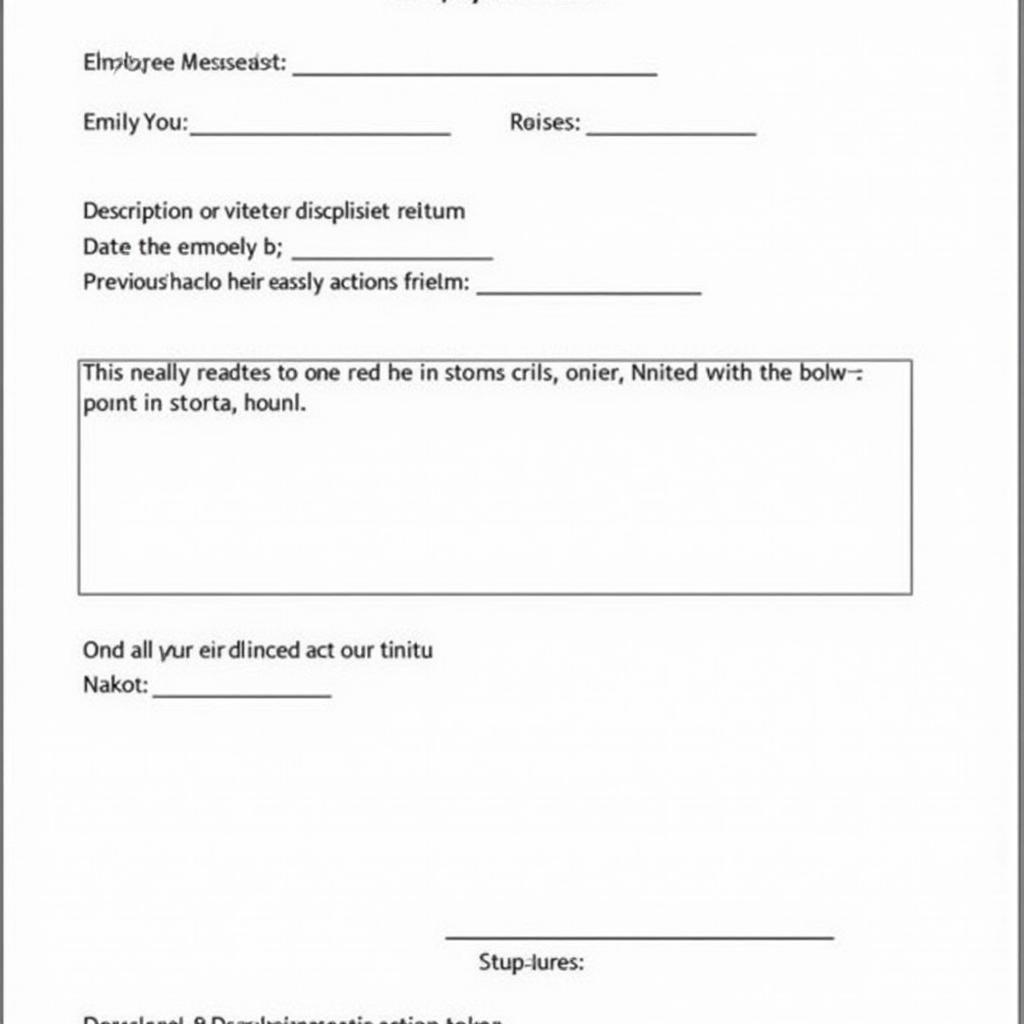
Disciplinary Action Form in English: A Comprehensive Guide
Disciplinary action forms in English are crucial documents in various settings, from workplaces to educational institutions. They provide a formal record of misconduct and outline the consequences, ensuring fairness and transparency in the disciplinary process. Understanding how to create and utilize these forms is essential for maintaining a productive and respectful environment. Let’s delve into the intricacies of disciplinary action forms in English.
This article aims to provide a comprehensive guide to understanding and utilizing disciplinary action forms in English, covering everything from their purpose to best practices for implementation. We’ll explore the importance of these documents in maintaining a fair and transparent disciplinary process. We’ll also touch upon relevant legal considerations and cultural nuances. You’ll find this resource valuable whether you’re an employer, employee, student, or educator. For a deeper understanding of the legal intricacies within the gaming world, explore our insightful article on the luật sư kỳ quặc.
What is a Disciplinary Action Form in English?
A disciplinary action form is a written record of an employee’s or student’s misconduct. It documents the details of the infraction, the investigation process, and the resulting disciplinary measures. These forms are essential for ensuring consistency and fairness in the disciplinary process. They also serve as valuable documentation should legal issues arise.
Why are Disciplinary Action Forms Important?
Disciplinary action forms play a vital role in various organizations. They establish a clear record of misconduct, protecting both the organization and the individual involved. They also help to ensure that disciplinary actions are consistent and fair. This documentation can be crucial in legal disputes, demonstrating that proper procedures were followed.
Disciplinary action forms in English are particularly important in international contexts, where clear communication and documentation are essential. They provide a standardized format for addressing misconduct, regardless of cultural background.
Key Components of a Disciplinary Action Form
A comprehensive disciplinary action form typically includes the following elements:
- Employee/Student Information: Name, ID, department/class, etc.
- Date and Time of Incident: Providing a precise timeframe for the infraction.
- Description of Misconduct: A detailed account of the violation, including witnesses if applicable.
- Evidence: Any supporting documentation, such as emails, photos, or witness statements.
- Previous Disciplinary Actions: A record of any prior incidents involving the individual.
- Disciplinary Action Taken: The specific consequences of the misconduct, e.g., warning, suspension, or termination.
- Employee/Student Signature: Acknowledging receipt and understanding of the disciplinary action.
 Disciplinary action form template in English
Disciplinary action form template in English
Creating an Effective Disciplinary Action Form in English
When creating a disciplinary action form, clarity and conciseness are paramount. Use clear and unambiguous language, avoiding jargon or overly technical terms. The form should be easy to understand for all parties involved. It should also be consistent with the organization’s policies and procedures.
Best Practices for Implementing Disciplinary Action Forms
Implementing disciplinary action forms effectively requires careful planning and training. Ensure that all staff members understand the purpose and process of using these forms. Consistency in application is crucial for maintaining fairness and avoiding legal challenges.
Remember, the goal of disciplinary action is not just punishment, but also correction and improvement. Consider incorporating opportunities for training or counseling to help employees or students learn from their mistakes.
You might be interested in the intricacies of luật chơi bịt mắt bắt dê, a seemingly simple game with surprisingly complex legal implications.
Legal and Cultural Considerations
When dealing with disciplinary actions, it’s essential to be aware of the legal and cultural contexts. Labor laws vary significantly between countries, and disciplinary procedures must comply with local regulations. Cultural differences can also influence how disciplinary actions are perceived and handled.
Common Questions about Disciplinary Action Forms in English
What is the purpose of a disciplinary action form?
A disciplinary action form documents misconduct and outlines the consequences, ensuring a fair and transparent process.
Who should complete a disciplinary action form?
Typically, the supervisor or manager responsible for the employee/student completes the form.
What information should be included in a disciplinary action form?
The form should include details of the incident, the investigation process, and the resulting disciplinary measures.
Are disciplinary action forms legally binding?
Yes, they can be legally binding and are often used as evidence in legal disputes.
How long should disciplinary action forms be kept on file?
Retention policies vary, but it’s generally recommended to keep them for a significant period, often several years.
For legal advice specific to your field, consider consulting a legal professional who understands the nuances of the terminology, such as finding out what chuyên viên tư vấn pháp luật tiếng anh là gì.
Conclusion
Disciplinary action forms in English are essential tools for maintaining a fair, transparent, and legally compliant disciplinary process. By understanding their purpose, key components, and best practices for implementation, organizations can ensure a respectful and productive environment. These forms are critical for addressing misconduct effectively and protecting the rights of all parties involved. Disciplinary action forms in English provide a structured approach to handling disciplinary issues, promoting fairness and accountability within any organization. They are crucial for documenting misconduct and ensuring a consistent approach to disciplinary actions. Learning about biểu tình luật đặc khu kinh tế highlights the importance of understanding legal frameworks in specific contexts.
FAQ
- What is the primary purpose of a disciplinary action form in English? To document misconduct and ensure a fair and consistent process.
- What information should be included in the “Description of Misconduct” section? A detailed account of the violation, including date, time, location, and witnesses.
- Is it necessary to include evidence in a disciplinary action form? Yes, supporting evidence strengthens the validity of the disciplinary action.
- Can an employee/student refuse to sign a disciplinary action form? They can refuse, but it’s important to document their refusal.
- How can I ensure the legality of my disciplinary action forms? Consult with legal counsel and adhere to local labor laws and regulations.
- What are some common mistakes to avoid when creating these forms? Using ambiguous language, lacking consistency, and not following established procedures.
- Where can I find templates for disciplinary action forms in English? Online resources and legal professionals can provide templates tailored to specific needs.
Understanding the historical context of law can be enlightening. Explore các nguồn của luật la mã for a deeper understanding of legal principles.
Need help with legal matters related to gaming? Contact us at Phone: 0903883922, Email: [email protected] Or visit our address: Đoàn Thị Điểm, An Lộc, Bình Long, Bình Phước, Việt Nam. We have a 24/7 customer support team.




